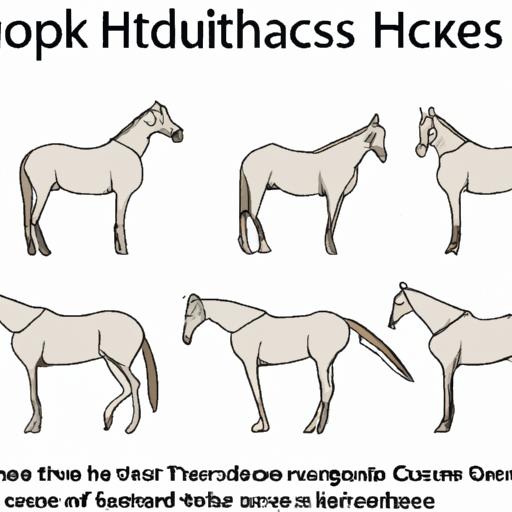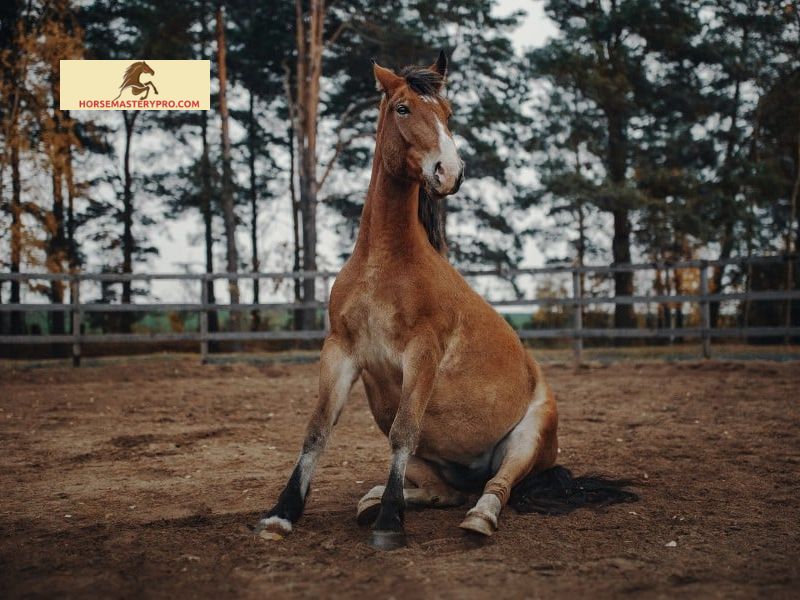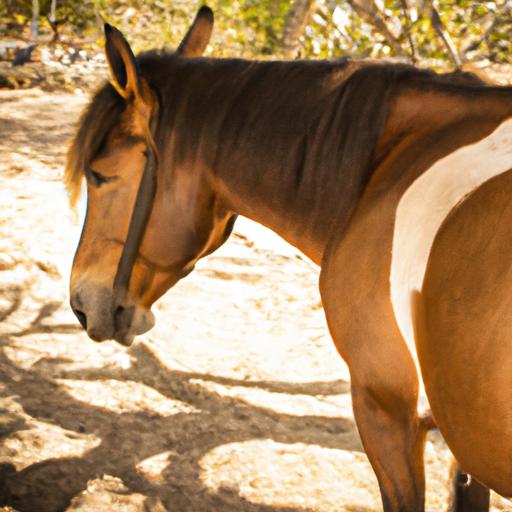Unveiling the truth: do horses sit down like humans? Explore common misconceptions and learn why their anatomy makes it impossible.
Introduction

Do Horses Sit Down? Have you ever wondered if horses sit down like humans do? It’s a fascinating question that often sparks curiosity among horse enthusiasts. In this article, we will delve into the intriguing world of horse resting behavior and uncover the truth behind whether horses actually sit down. Understanding how horses rest is crucial for their overall well-being, as it allows us to provide them with the optimal care they deserve.
Horses are magnificent creatures known for their grace and power. Their anatomy and physiology play a significant role in determining their resting habits. While horses may not sit down in the traditional sense, they have their unique ways of finding rest and relaxation. So, let’s embark on this journey together and unravel the secrets of horse resting behavior.
As responsible horse owners, it’s essential to comprehend the various positions horses adopt while resting. By understanding their natural tendencies, we can ensure their comfort and happiness. Moreover, gaining insight into horse resting behavior allows us to recognize signs of distress or discomfort, enabling us to address any underlying issues promptly.
So, saddle up and join me as we explore the fascinating world of horse resting behavior. In the next section, we will delve deeper into the anatomy and physiology of horses to understand why sitting down, as humans do, isn’t a part of their repertoire. Let’s get started on this enlightening journey together!
Stay tuned for Section II where we’ll dive into the intriguing world of horse anatomy and physiology, shedding light on their natural stance and rest positions.
Horse Anatomy and Physiology

Horses possess a remarkable skeletal structure and muscular system that contributes to their powerful and agile nature. Understanding their anatomy is key to comprehending their resting behavior.
A Closer Look at Skeletal Structure
Horses have a unique skeletal structure that allows them to bear their weight efficiently. Their long, slender legs and hooves, designed to support their massive bodies, are well-adapted for locomotion. Unlike humans, horses have a limited number of bones in their legs, which are elongated to provide strength and flexibility.
Muscular System and Natural Stance
The muscular system of a horse is essential for maintaining balance and facilitating movement. Horses have well-developed muscles throughout their bodies, particularly in their legs and back. These muscles provide the strength and stability necessary for various activities, including resting.
When horses are at rest, they assume different positions to alleviate fatigue and distribute weight evenly. Their natural stance involves keeping their legs slightly bent, allowing them to take the weight off their hooves without fully sitting down. This resting position enables them to relax their muscles while remaining in a state of alertness.
The Myth of Sleeping While Standing
You may have heard the saying, “asleep on your feet like a horse.” While horses can sleep while standing, it’s not their primary mode of deep sleep. They have a unique ability to lock their joints using a stay apparatus, allowing them to doze off without collapsing. This adaptation is advantageous in the wild, where horses need to be alert to potential dangers even while resting.
However, horses require deep sleep for their overall well-being. To achieve this, they lie down on their sides, a position that enables them to fully relax their muscles and enter a state of restorative sleep. So, while horses can doze off while standing, they rely on lying down to experience the rejuvenating effects of deep sleep.
In Section III, we’ll explore the various resting positions horses adopt and the factors that influence their resting habits. Get ready to delve into the intriguing world of horse resting behavior!
Horse Resting Behavior
Horses have their unique ways of finding rest and relaxation. Observing their resting behavior can provide us with valuable insights into their well-being. So, let’s take a closer look at how horses rest and the various positions they adopt.
Description of How Horses Rest and Relax
When horses take a break to rest, they often exhibit fascinating behaviors that reflect their innate instincts. One common resting position is the “stay apparatus,” where horses stand with their hind legs slightly bent, allowing them to rest while remaining upright. This posture enables them to relax their muscles and conserve energy without fully lying down.
However, horses also have a preference for lying down to achieve a deeper state of relaxation. Unlike other animals, horses require deep sleep, during which they can fully relax and rejuvenate. During this time, their bodies can repair and replenish, ensuring their overall well-being.
Different Resting Positions Adopted by Horses
Horses have a repertoire of resting positions that they assume when they choose to lie down. One position often seen is the lateral recumbency, where horses stretch out on their sides. This allows them to distribute their weight evenly and relieve pressure from their legs and hooves. You may have also noticed horses resting on their sternum, almost resembling a dog’s position. This variation allows them to rest while keeping their legs tucked underneath them, ready to spring back into action if needed.
Explanation of Horse’s Preference to Lie Down for Deep Sleep
You might wonder why horses prefer to lie down for deep sleep rather than standing up. The answer lies in their unique anatomy and physiology. Horses have a large, heavy body, and standing for prolonged periods can strain their muscles and joints. Lying down allows them to fully relax and alleviate the pressure on their limbs, promoting better blood circulation and preventing the development of conditions like hoof issues or bedsores.
By understanding the different resting positions horses adopt, we can ensure that they have suitable resting environments that cater to their natural instincts and needs. Providing them with comfortable, clean bedding and adequate space to lie down not only contributes to their physical well-being but also enhances their mental state, leading to happier and healthier horses.
In the upcoming Section IV, we will explore the various factors that influence horse resting habits, shedding light on the impact of age, health, and the environment.
Factors Influencing Horse Resting Habits

When it comes to horse resting habits, several factors come into play. Understanding these influences is crucial for maintaining the well-being of our equine companions. Let’s explore some key factors that shape horse resting behavior.
Influence of Age, Health, and Environment
Just like humans, horses’ resting habits can vary depending on their age and overall health. Younger horses, especially foals, tend to require more rest as they grow and develop. Older horses, on the other hand, may have specific needs due to age-related conditions such as arthritis. It’s essential to consider these age-related factors when providing suitable resting conditions for horses of different age groups.
Moreover, the environment in which horses live significantly affects their resting habits. Horses kept in a pasture setting have the freedom to move around and find their preferred resting spots. They can lie down comfortably on grass or soft ground, allowing for deep and restorative sleep. In contrast, horses housed in stables may have limited space and access to natural resting surfaces. Providing appropriate bedding and comfortable resting areas becomes crucial in such cases.
Impact of Pasture and Stable Conditions
The conditions in which horses are kept also play a vital role in their resting behavior. Horses in well-maintained pastures with ample grazing opportunities tend to exhibit more natural resting patterns. Access to fresh air, natural sunlight, and social interaction with other horses promotes a sense of well-being, positively impacting their resting habits.
Conversely, horses confined to stables for extended periods may experience altered resting behaviors. Limited movement, lack of social interaction, and reduced access to natural forage can affect their overall well-being. As responsible horse owners, it’s important to provide regular turnout, mental stimulation, and appropriate exercise to counteract the potential negative effects of stable confinement.
Horse’s Herd Behavior and Social Dynamics
Horses are social animals with a strong herd instinct. Their resting habits are influenced by their interactions with other horses. In a herd, horses often take turns keeping watch while others rest to ensure the safety of the group. This instinctual behavior can manifest even when horses are kept individually or in small groups. Understanding and respecting their social dynamics can help create a harmonious environment that supports their natural resting patterns.
By considering these factors – age, health, environment, and social dynamics – we can better meet the resting needs of our equine friends. Providing them with suitable conditions and a comfortable resting environment fosters their overall well-being and contributes to their happiness.
Stay tuned for Section V, where we’ll debunk common misconceptions about horses sitting and shed light on their true resting positions.
Conclusion
In conclusion, understanding the intricacies of horse resting behavior is crucial for providing the best care for these magnificent creatures. While horses may not sit down like humans, they have their unique ways of finding rest and relaxation. By debunking the common misconception of horses sitting like humans, we can appreciate their natural anatomy and physiology.
Throughout this article, we explored the fascinating world of horse resting behavior, beginning with an introduction to the topic and the importance of understanding horse habits. We then delved into the anatomy and physiology of horses, discovering why sitting down, as humans do, isn’t a part of their repertoire.
We also addressed common misunderstandings about horse resting positions, clarifying why horses cannot fully sit down due to their anatomy. By shedding light on these misconceptions, we can ensure accurate knowledge and better horse care practices.
As horse owners and enthusiasts, it is our responsibility to provide suitable resting conditions for our equine companions. Understanding their preferences and needs allows us to create a comfortable and safe environment for them to rest and rejuvenate.
Remember, horsemasterypro.com is here to guide you in your journey as a horse owner. By continuously expanding our knowledge of horse behavior, we can deepen our bond with these incredible animals and provide them with the care they deserve.
So, let’s embark on this exciting journey together, always seeking to improve our understanding of horses and the way they rest. Stay curious, stay compassionate, and keep exploring the wonders of the equine world.
Thank you for joining us on this enlightening exploration of horse resting behavior. If you have any questions or insights to share, feel free to reach out to us at horsemasterypro.com. Until next time, happy horsekeeping!


